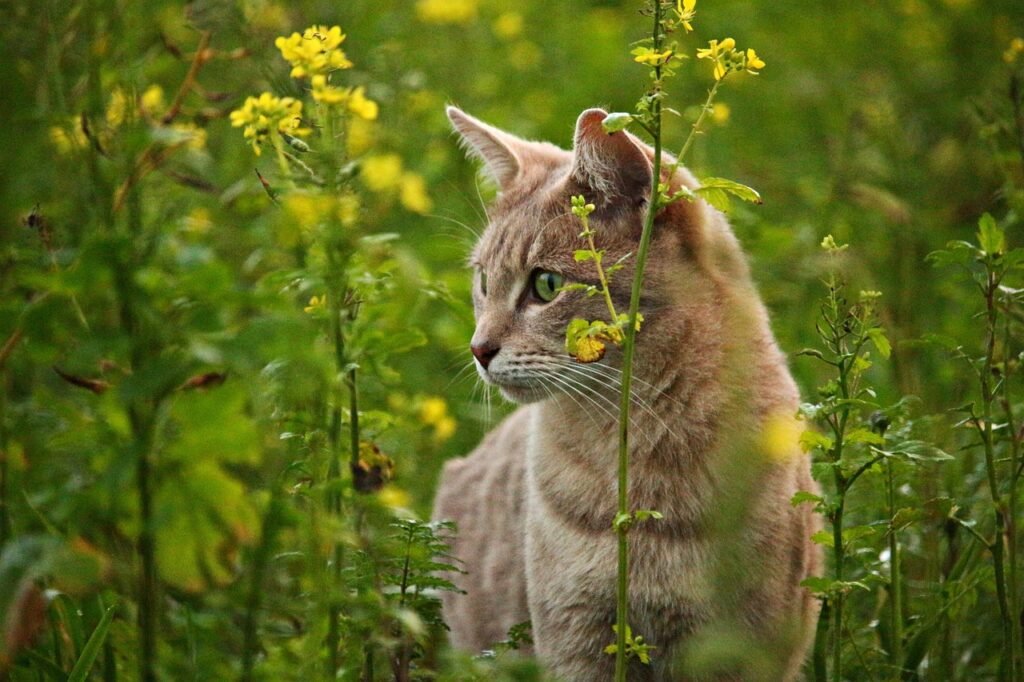Cats’ whiskers are not just an adornment; they are sensitive tools that help them understand their environment. Each whisker is deeply embedded with nerve endings, allowing cats to detect minor changes in their surroundings. They use these tactile hairs to navigate tight spaces, gauge the width of openings, and even sense changes in air currents, which can indicate nearby movement.
Superior Night Vision

Cats are renowned for their ability to see in low light conditions. Their eyes have a higher concentration of rod cells, photoreceptors that detect dim light. Additionally, a reflective layer behind the retina called the tapetum lucidum enhances their night vision by reflecting light through the retina a second time, giving their eyes that characteristic glow in the dark.
A Different Kind of Color Perception

While cats don’t see the world in black and white, their color vision is not like humans’. They mostly perceive the world in shades of blue and green. Cats lack the red-sensitive cone cells humans have, which means they struggle to differentiate between reds and pinks, often seeing them as shades of gray.
Exceptional Hearing Abilities

Cats can hear a broader range of frequencies than both dogs and humans. Their auditory range starts from 48 Hz and extends up to 85 kHz, allowing them to detect the high-pitched sounds that many of their prey make. Cats’ ears can also rotate independently to pinpoint the source of a sound more accurately.
Unique Sense of Smell

The feline sense of smell is highly developed, with around 200 million scent receptors in their noses, compared to a human’s 5 million. Cats rely heavily on scent to communicate with other felines, mark their territory, and even assess the edibility of food.
Pheromone Communication

Cats utilize pheromones as a form of chemical communication. By rubbing their face against people or objects, they deposit pheromones from glands located on their cheeks. This behavior marks those people or objects as familiar and safe, establishing their territory and signaling contentment.
Sensitivity to Vibrations

Cats possess an acute sensitivity to vibrations, which can alert them to approaching threats or the presence of prey. Through their paws and body, they can detect vibrations that humans cannot, offering them a survival advantage in the wild as well as making them highly aware of their surroundings.
Temperature Preferences

While most people know that cats love warmth, few realize just how sensitive they are to temperature variations. Cats prefer environments around 86 to 97 degrees Fahrenheit, much warmer than the ambient temperature humans usually find comfortable. Their coat and skin adapt to maintain this preference, aiding their comfort.
Communication Beyond Meows

Cats have diverse communicative tools besides meowing, which is typically reserved for interacting with humans. They employ body language, purring, hissing, and a range of vocalizations to convey different emotions and intentions. Each cat develops a unique language with their human companions based on their interactions.
Memory and Cognitive Skills

Cats are more intelligent and have better memories than they are often given credit for. They can remember obstacles in their environment, recall positive or negative experiences, and even solve simple puzzles. Their cognitive abilities allow them to learn from their surroundings and adapt their behaviors accordingly.
Hi, I’m Bola, a passionate writer and creative strategist with a knack for crafting compelling content that educates, inspires, and connects. Over the years, I’ve honed my skills across various writing fields, including content creation, copywriting, online course development, and video scriptwriting.
When I’m not at my desk, you’ll find me exploring new ideas, reading books, or brainstorming creative ways to solve challenges. I believe that words have the power to transform, and I’m here to help you leverage that power for success.
Thanks for stopping by, Keep coming to this website to checkout new articles form me. You’d always love it!






